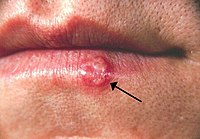
Photo from wikipedia
Bone marrow fibrosis (BMF) is manually assessed by reticulin and trichrome stain of bone marrow (BM) biopsy and graded on a semi-quantitative scale. Krebs von den Lungen 6 (KL-6) and… Click to show full abstract
Bone marrow fibrosis (BMF) is manually assessed by reticulin and trichrome stain of bone marrow (BM) biopsy and graded on a semi-quantitative scale. Krebs von den Lungen 6 (KL-6) and Mac-2 binding protein glycosylation isomer (M2BPGi) are known to be associated with lung and liver fibrosis, respectively. We explored the usefulness of KL-6 and M2BPGi to assess BMF. A total of 250 patients who underwent BM biopsy with hematologic or non-hematologic diseases were included, and 42 patients with lung and liver diseases were excluded. The patients’ data, including age, sex, diagnosis, white blood cell, hemoglobin (Hb), platelet, and lactate dehydrogenase (LDH) were collected. Measured KL-6 and M2BPGi levels were compared with reticulin grade (RG) (grade 0–3). KL-6 levels were significantly elevated with an increase in RG, but M2BPGi did not show a significant difference. Hb, LDH, or KL-6 were independent predictors for BMF (odds ratio: 1.96, 2.26, 2.91, respectively), but showed poor predictive ability (area under the curve [AUC] 0.62, 0.61, 0.60, respectively). The combination of Hb, LDH, and KL-6 showed a significantly improved predictive ability for BMF (AUC 0.73; integrated discrimination improvement 0.057; category-free net reclassification improvement 0.625). This is the first study to evaluate the usefulness of KL-6 for assessing BMF. The combination of Hb, LDH, and KL-6 would be an objective and relevant biomarker approach and be applied to risk stratification for BMF.
Journal Title: Diagnostics
Year Published: 2022
Link to full text (if available)
Share on Social Media: Sign Up to like & get
recommendations!